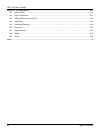
AES-100 User’s Guide
1-2 Getting to Know the AES-100
IEEE 802.1Q Tagged VLAN
Your AES-100 uses the IEEE 802.1Q Tagged VLAN (Virtual Local Area Network) which allows your device to
deliver tagged/untagged packets to and from its ports. The AES-100 supports up to 255 VLANs and the maximum
VLAN ID 4094.
IEEE 802.1p Priority
IEEE 802.1p Priority gives your AES-100 the ability to regenerate priority changes for ports.
Fast Mode
The AES-100’s fast mode makes use of the “tag” subset of the IEEE 802.1Q standard to identify the source port of
a frame and speed traffic through a service gateway.
MAC (Media Access Control) Filtering
Use MACfilter commands to filter incoming packets based on MAC (Media Access Control) address(es) that you
specify. You may enable/disable specific ports. You may specify up to five MAC addresses per port.
Secured Host
Allow up to ten remote hosts to access your AES-100 via IP addresses you specify.
System Error Logging
The system error log will record error logs locally to the AES-100 memory. These logs may be viewed again after a
warm restart.
UNIX Syslog Logging
Use UNIX syslog commands to send logs to your UNIX server.
Protocol
•
Multiple Protocols over AAL5 (RFC 1483)
Management
•
Remote configuration backup/restore and firmware upgrade
•
SNMP manageable
•
Text-based management locally via console port and remotely via telnet
Security
•
Password protection for system management
•
Port-based VLAN
IGMP Snooping
IGMP (Internet Group Management Protocol) snooping reduces multicast traffic for maximum performance.
Overheating Detection and Warning
•
An ALM LED turns on when the AES-100’s internal temperature is too high and turns off when the
temperature has returned to a normal level.


















